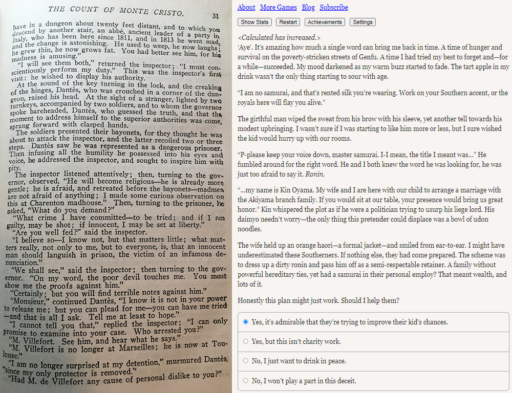‘How the words look on a page’ sounds pretty silly compared to premise lines and grammatical structure, but it’s an important part of the process all the same. Too many writers struggle to see the forest for the trees–or the pages for the sentences, in this case–which can come back to bite them in terms of presentation.
As an author, you can’t just be concerned with what your words say: their looks matter, too!
Proofreading
While I edit my chapters in Google Docs before programming them into choicescript with Notepad++, I always make sure to proofread the product in its final form. I always find errors and revisions to be made, but those are secondary concerns for my initial play-through.
The things I’m looking for may seem trivial and petty to some, but when it comes to presenting your work as best you can, it’s your job to sweat the small stuff.
What I Avoid
• 3 or more consecutive paragraphs starting with the same letter
• 5 or more lines per paragraph on PC
• Sentences in paragraphs that start and end across an entire, single line
• 2 or more consecutive single-line paragraphs
They may seem like silly pet peeves, but aesthetics and health go hand-in-hand. If something looks off, chances are, something is. Here’s what each of those peeves mean on a deeper level.
• 3 or more consecutive paragraphs starting with the same letter
Hitting the reader with the same capital letter is jarring–even if they belong to entirely different words! It increases visual confusion: if the reader takes their eyes off the text or otherwise forgets what paragraph they’re on, there’s going to be a moment of distress before they find their place again.
• 5 or more lines per paragraph on PC
While this peeve is very medium dependent, and with smaller devices you’re certainly going to go over this limit, I’ve found that–on 680-pixel width (that choicegames use on PCs)–anything more than four lines long starts to look like a wall of text. Readers have shorter attention spans now than any point in history: don’t intimidate them!
• Sentences in paragraphs that start and end across an entire, single line
This one doesn’t happen often, but if you write enough you’ll come across these ugly creatures from time-to-time. They’ll be awkwardly sitting atop your paragraphs or laying uncomfortably beneath them. It’s not your fault the sentence came out so eerily sized, but there’s no one else to blame if you keep it that way.
• 2 or more consecutive single-line paragraphs
This has more to do with choicescript than traditional fiction–the differences of which I’ll go into later–but to cut it short: every paragraph has a gap between them in choicescript. While this helps readability, it can hurt your style especially with multiple, single-line paragraphs. Consider using *line_break in situations like these.
What I Look For
• Around 8 paragraphs before a choice occurs
• 1 or more <Stat> paragraph for each page
• Choices that sit well on top of eachother
While I wouldn’t go so far as to say writing choicegames is formulaic (I’m not that jaded, yet!) there are conventions every choicegame author adopts eventually. These are some of mine:
• Around 8 paragraphs before a choice occurs
When it comes to maintaining reader expectations, consistency is king. Not just for them: I’ve developed an innate sense of when it’s time to reel back in a choice to the main branch and to get the reader back on track for the next choice.
As the author, you want this to become second-nature: it makes the ‘interactive’ part less of a juggling act and allows you to focus more mental energy on steering your unicycle of a story!
Another reason to use eight or more paragraphs a page involves temptation. It is far too tempting, upon selecting that giant ‘Next’ button, for one’s eyes to latch down to the next set of choices. It’s a natural temptation, but the last thing you want is readers skipping portions of your text and then getting upset on the forums that they didn’t understand the choice!
• 1 or more <Stat> paragraph for each page
Not to toot my own horn, but one of the best design decisions I made was including a little tag on a few of my paragraphs. While seeing something like <Perverted> is going to (momentarily) take the reader out of the story, what I get in return for that is very valuable.
The second most important thing for a choicegame author to do is to make sure that the player’s choices and customization options matter. The first is to make sure the player notices that! It doesn’t matter how branchy or variable-heavy your narrative is if only hyper-perceptive readers can pick up on the differences.
Do anything and everything you can to make sure your reader knows what they’re reading has been tailored to them. It’s going to make them feel special and add to their experience.
• Choices that sit well on top of eachother
There’s an art to writing choices that even I haven’t quite mastered over the years. You want to make each as clear as possible, if they’re tied to a stat check, but you also want to make them attractive. Equally so, if you can help it.
I’m not just talking about the content, but the length of the choices, the number of sentences, the use of exclamation marks–these are all factors that, in many ways, you want to keep mostly uniform outside special exceptions.
Every choice should have an equal ‘umph’ to it, and none of them should disappoint.
Traditional Novels vs Choicescript
Style vs practicality, antiquity vs modernization, refined vs palatable, soul vs soulless…ahem. Memes aside, choicegames don’t look like any novel I’ve ever read! I’m not a prolific reader, but I’m pretty sure a book is supposed to look more like the first image and less like the second.

Let’s ignore the fact that I’m comparing my samurai smut game to Alexandre Dumas’s literary classic for a second and focus on appearances. What effect does it have when you look at one as opposed to the other?
In this book of The Count of Monte Cristo published in 1912, there’s no gaps between paragraphs, and–while I’m not sure what the font is–it sure wasn’t printed in Georgia or Times New Roman. In fact, it’s monospaced: every letter is given an equal amount of space. Makes sense, considering it was typed up on a typewriter!
Which do you prefer, monospace or proportional, and why? Let me know in the comments below–and sorry for sounding like a youtuber!
In Monte Cristo, there’s an average of around eleven words a line as opposed to sixteen, with a physical length difference of around 40% compared to SoH. This matters when it comes to moving your eyes, and it’s the reason choicegames top out at 680 pixels even on super-wide displays.
Another difference of note is–you guessed it–tabs! It’s what keeps a bunch of paragraphs from becoming a wall of text, and is absolutely necessary when they sit on top of eachother like they do in Monte Cristo. I love tabs, yet sadly they seem to be going the way of…
The Typerwriter’s Two Spaces
Even for a (currently) 32-year-old millenial, there’s a few things I’m oddly oldschool about. You can see the evidence yourself in the code for Fatehaven as well as Samurai of Hyuga Books 1 & 2. That’s right: until after 2016, I ended every sentence with two spaces at the end–not one.
 Is that weird, or what? The reason for the additional space after punctuation was because of the monospace font typewriters used: two spaces were needed to identify full stops. Since monospace fonts are so rarely used, the need for the additional spacing has died.
Is that weird, or what? The reason for the additional space after punctuation was because of the monospace font typewriters used: two spaces were needed to identify full stops. Since monospace fonts are so rarely used, the need for the additional spacing has died.
It was a habit I was able to drop surprisingly quickly, though I’m not going to lie: there was something satisfying about drumming the space bar in rapid succession.
Summary
While nothing in this post is going to elevate your writing to some upper echelon, I hoped it made you think of things you otherwise wouldn’t have noticed. Don’t be afraid to take a shallow look at your work–and keep those pages pretty!


First of, I would like to say thank you for this amazing series that you have created (and am lucky enough to have found it), i have read/played over a dozen games in Hosted and Choice of Games and i have only found 3 that could only be described as perfect, you know the kind, when you want to rate it more than it lets you, because let’s be honest this book deserves more than a measly 10/10 and 7 bucks. Both Fallen Hero and Wayhaven were amazing books but SOH brought a rare side of me (kinda embarrassed to admit this) but I actually cried (like REALLY cried), the only thing that had made me cry after my toddler years was the Green Mile and Hachiko (highly recommend movies!) that’s it two times since i have learned to swim. To be honest i have never really given much emotion let alone cry to a character that i couldn’t see nor hear, and so with my clueless self not ready for what was to come, reading for the first time the final chapter of the fourth book shattered me emotionally so much so that felt like I was the one losing Junko, prior to that point i hadn’t realised how much invested i was in the characters (and Junko’s story in particular). Anyway i know this isn’t related to your post so sorry about that (and for this small essay of a comment 😅) but i needed you to know just what a master piece of a book you have created my best wishes from Athens (also sorry for my bad grammar English isn’t my first language)
– Alex
When it comes to which I prefer, I have to say, it really depends where I am reading it on. If it is printed text, I prefer text without gaps between paragraphs (unless there is a bigger jump in time or location) and a font with serifs because it is simply easier on the eye. In digital form though I prefer gaps between the paragraphs and a font without serifs, also because it is easier to read. That said, if I printed the Samurai of Hyuga and converted the Count of Monte Cristo into an E-book, their look would needed to be reversed to be comfortable to read.
I don’t know how but you always seem to write an article that helps me with something I’m struggling with in recent times. Before it was drafts and now – organization, and each time you bring such a clarity that further redefines why I appreciate your work and effort that much more. It’s always refreshing to see what you put out – be it a project, or just a simple article like this. Thank you so much for keeping my love of writing alive.